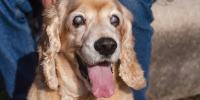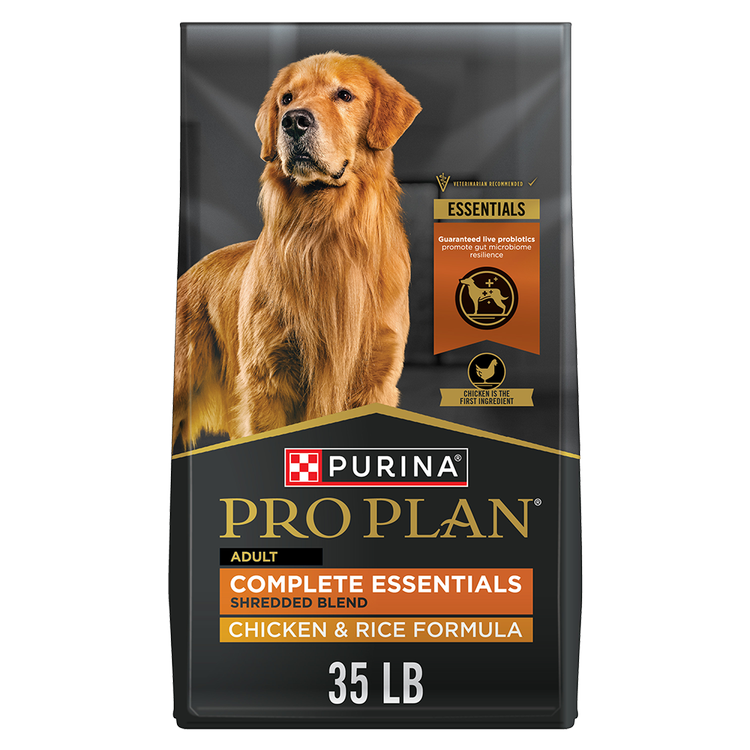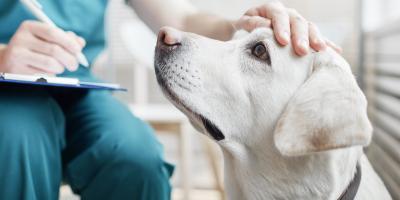Cataracts in Dogs: Signs, Symptoms & Treatment


Some of the sweetest moments we have are looking into our buddy’s adorable eyes. However, if your dog has a cloudy, opaque film growing over one or both of their eyes, our sweet moments can quickly turn into concern. If you see this, then it is most likely a cataract, and if left untreated it can take over your dog’s eye leading to blindness.
Cataracts are imperfections that cloud the lens of the eye and create a white discoloration, which can lead to blurry vision. The lens is a structure in the eye that is composed of protein fibers and oversees the focusing of light onto the retina to create clear vision. When a cataract forms on top of the lens, then this blocks a lot of that light from reaching the retina developing vision issues in your pup.
What Causes Canine Cataracts?
There are a few reasons a dog might get cataracts:
- Genetics. In most situations, cataracts are inherited and can be seen at many different ages, especially in senior dogs. In this case, your vet can help you find the best treatment plan for your buddy.
- Aging. As dogs grow older, they can run into different vision-related issues, such as cataracts. Sometimes it is a natural growth and other times there could be an age-related disease that is putting your dog at a higher risk of developing cataracts.
- Underlying medical condition. There are certain medical conditions which increase the chances of your dog getting cataracts, including diabetes and glaucoma. For example, dogs with diabetes have a 75% chance of developing cataracts along with a 75% chance of losing their vision completely within 6-12 months, if left untreated. Reach out to your vet or animal hospital as soon as possible if you suspect your dog has a serious medical condition.
- Nutritional imbalance. This is often seen within the first few weeks of a puppy’s life, especially if they are on a commercial milk replacer supplement. If puppies aren’t getting the proper nutritional support when they are young and now their amino acid, calcium, and other levels are too low, this could cause cataracts in the little furball. The good news is nutritional cataracts have a high chance of improving as the puppy ages and will usually not interfere with their vision.
- Trauma. If a dog’s eye got injured from something hitting the lens, an electric shock, exposure to a toxic substance or radiation, or some other form of trauma, then this could destroy and rupture a dog’s lens enough to cause cataracts and other vision concerns. If you suspect your dog has had trauma to the eye, see your veterinarian immediately.
If you suspect that your dog is forming cataracts, contact your vet and they will run tests to see what is causing your dog’s lens to cloud over.
How Do Vets Diagnose Cataracts?
When early signs of cataracts show up, most of the time your veterinarian will give your dog an ophthalmic exam. They will use an ophthalmoscope to check the internal structures of the eye and see if there are any abnormal opacities forming on the lens. Dilating your dog’s eyes and running other diagnostics tests might be needed to get a better look at the cataract edges and the back of the eye (if possible). A few of those tests might include the following:
- Slit lamp biomicroscopy. This is where they shine a special light in the dog’s eye to get a direct examination of the lens.
- Schirmer tear test. This is where they place a small filter paper inside the dog’s lower eyelid to check for moisture content and measure tear production.
- Fluorescein stain. This is where they stain the dog’s eyes with a neon orange or yellow substance to evaluate the surface of the eyeball, see if there are any defects in the cornea that need addressing, and check for any scratches or foreign materials in the eye.
- Tonometry.
- Other tests. Your vet might need to run other types of tests, such as a blood count test, electroretinography, and more. This is to ensure that what you are seeing is in fact cataracts and not another condition, as well as seeing if there are any other underlying medical reasons your dog has cataracts. They will also need to assess how bad the cataracts are to figure out the best treatment options for your dog.
Once your vet has run their tests, they will have a better idea of how bad the cataracts are and what is causing them. Usually, the severity of cataracts is categorized as follows:
- Incipient. This is when the cataracts are so small that they need to be magnified to be diagnosed. It covers less than 15% of the lens and usually doesn’t cause any visual deficits.
- Immature. This is when more than 15% of the lens gets covered and multiple layers will start to develop in different areas. The retina can still be seen, and it could cause mild visual deficits, such as blurry vision.
- Mature. At this stage, you can no longer see the retina or the lens. Visual deficits become greater and can lead to blindness or near blindness.
- Hypermature. This is when the lens begins to shrink and the capsule on the lens appears to be wrinkled. Inflammation of the eye occurs at this stage and can lead to glaucoma, if left untreated. Glaucoma is an incredibly painful experience for dogs and needs proper treatment to ensure it doesn’t grow worse.
As soon as your vet knows what is going on with your buddy, they will be able to tell you about the various treatment plans out there and the two of you can decide what is best for your dog.
Symptoms of Cataracts in Dogs
At the beginning stages of cataracts, there might not be many noticeable symptoms. As the cataracts progress, more symptoms will start to show, especially if it is causing vision impairment:
- Changes in the eye appearance, such as a cloudy film over the eye
- Inflammation in the eye
- Squinting or scratching at the eyes
- Clumsiness
- Bumping into furniture, door frames, walls, and other items
- Trouble locating their food or water bowls
- Difficulty finding their toys and treats that have been tossed to them
- Hesitant to walk downstairs
- Using their other senses in place of vision, such as walking with their nose to the ground and sniffing out their surroundings
- Barking at inanimate objects or familiar people
- Changes in their blinking patterns or a weeping eye
- Flinching or jumping when someone pets them near their eyes
- Anxiety, especially in dim lighting or at night
- Dizziness
- Disorientation or confusion
- Slow movement
- Restlessness
If there are other underlying medical issues, other symptoms associated with that illness might occur alongside the cataracts, such as increased thirst, lethargy, frequent urination, and more. Be on the lookout for any changes in their vision, especially as they age.
Dog Breeds Prone to Developing Cataracts
There are certain breeds of dogs that are more susceptible to developing cataracts compared to other breeds. Some of these breeds include the following:
- Afghan Hound
- American Staffordshire Terrier
- Bernese Mountain Dog
- Boston Terrier
- Chesapeake Bay Retriever
- Cocker Spaniel
- French Bulldog
- German Shepherd
- Golden Retriever
- Havanese
- Labrador Retriever
- Maltese
- Old English Sheepdog
- Pekingese
- Poodle
- Samoyed
- Schnauzer
- Shih Tzu
- Siberian Husky
- Staffordshire Bull Terrier
- Welsh Springer Spaniel
- West Highland Terrier
- Yorkshire Terrier
Most hereditary cataracts are found in puppies between 1-5 years old. However, while genetics can certainly play a part, we must keep in mind that it is possible for any breed of dog to develop cataracts at any age.
Dog Cataract Surgery
The most common treatment for cataracts is surgery. Cataracts surgery for dogs has been around for decades and is quite effective with success rates ranging from 85-90%. Your vet will most likely refer you to a board-certified veterinary ophthalmologist for a consultation and to see if your dog is a good candidate for surgery. They will perform tests, such as an electroretinogram and ultrasound to check the attachment and functionality of the retina.
If surgery is needed, then your dog might be given preoperative medications that they must take for several days to a few weeks. This will help decrease any inflammation in the eye and control the growth of the cataracts. The surgery itself is fast and entails the surgeon cutting a tiny incision to remove the affected lens. There is even a modern surgical method called phacoemulsification, which involves emulsifying (or liquefying) the eye lens using an ultrasonic probe. Once the lens has been liquified and removed, a salt solution is used to replace lost fluids. It is possible that your dog might need a corrective or artificial lens, like a contact lens, permanently implanted on the eye during the surgery.
After the operation, your dog might need to stay overnight so that the veterinarians can keep a close eye on their recovery. Once your dog is released from the vet, the first two weeks are the most critical recuperation period. During this time, they will need cataract medicine and regular checkups with your vet until they are fully healed. You might see some discomfort and inflammation, which will need to be managed by giving your dog eye drops multiple times a day. Your dog will need to wear a cone or an Elizabethan collar to keep them from injuring their eye during recovery. You will also need to limit your walks and follow your vet’s post-care instructions as closely as possible. If you follow these steps, then most dogs regain their eyesight within a matter of days.
Nonsurgical Dog Cataract Treatments
Unfortunately, there aren’t a lot of options for dog cataracts without surgery. There is some ongoing research for topical aldose reductase inhibitors (ARIs) that have shown some effectiveness in dogs that have diabetes. These drugs, however, tend to be expensive and must be given every 8-12 hours without any interruption in the treatment. There are also medicines for dogs like corticosteroids or nonsteroidal anti-inflammatory eye drops that help to decrease inflammation within the eye, but they don’t really treat the cataract. They only help to control inflammation to prevent diseases such as glaucoma. Most nonsurgical efforts are usually focused on taking preventative measures to decrease the chances of your dog getting cataracts and having their vision impaired.
Preventing Dog Cataracts
There are a few preventative measures that can be taken to manage cataracts in your dog:
- Feed your dog a high-quality diet that has a lot of omega-3 fatty acids to help them improve their eye health
- Give your dog antioxidants and supplements that will support healthy eye function
- Maintain a healthy weight and lifestyle for your dog according to their breed and age
- Keep your dog active and provide them with daily exercise, which will prevent diseases that can affect the eyes
- Protect your dog from harmful UV rays by providing them with lots of shade when they are outdoors and/or getting them protective goggles to wear outside
- Do not breed affected dogs to keep any hereditary conditions from continuing in future generations
- Have your veterinarian do regular eye checkups, especially if your dog is a breed that is prone to cataracts
- Seek medical assistance immediately if trauma occurs in your dog’s eye area
Sometimes prevention is better than trying to find a cure. Ensure that you stay on top of your buddy’s eye health, so that they can live their best life well into old age.
For more expert tips on the health of your dog, explore our other dog health articles.
Related articles

Reward Yourself with myPurina
Earn and redeem rewards for Purina products with the myPurina app.






